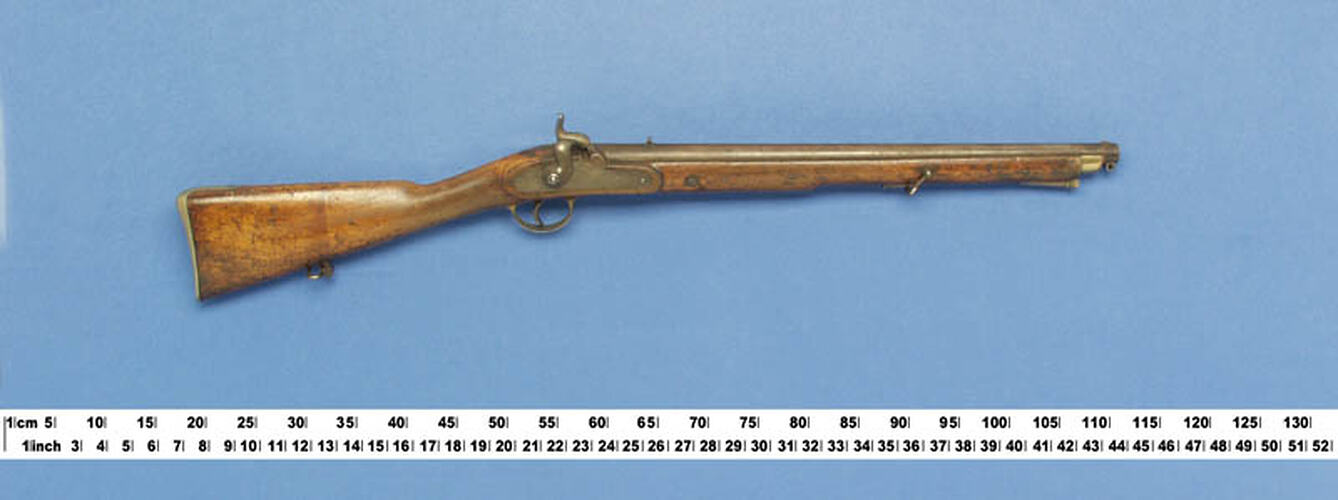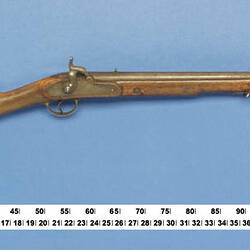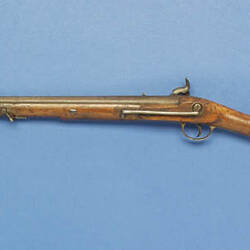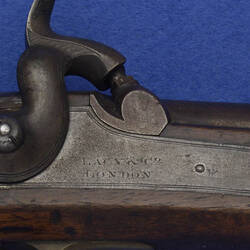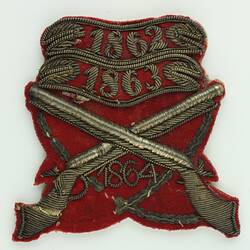Summary
British Service percussion carbine, Cavalry Carbine, cal. .657in., steel rifled (four groove) round barrel, 536 mm long. Made by Lacy & Co., London, 1850s.
One of 26 guns donated in 1871 by the Victorian Ordnance Department from its Melbourne Armoury, for the newly created Industrial and Technological Museum. The display was intended to show mechanics and gunsmiths the principles of gun construction and recent technical developments in weapons.
Physical Description
Steel side lock and hammer on R.H. side, brass oval triggerguard with small front spur, two brass 'Lovell's sidenail cups' for lockplate screws on L.H.side with steel saddle bar and ring monted over the top, brass foreend, butt plate, two sling swivels, one mounted from in front of rear ramrod tube, the other into underside of butt. Barleycorn foresight, V-notch rear sight, barrel fastened to stock via two barrel keys, steel swivel ramrod missing, two brass ramrod tubes, the front one being trumpet shaped. This item is something of an oddity. The former record described it as a Cavalry Carbine (Police), and while this is correct in so much as it is a carbine for cavalry use, as denoted by the saddle bar and ring, as a model it does not identify with the common carbines of this period. It appears to be a fusion between an 1844 Yeomanry Carbine and the 1856 Cavalry Carbine, having no barrel bands, a trumpeted forward ramrod tube, and the fixed notched rear sight of the former, but the Pattern 1853 lock and plain brass triggerguard of the latter. The fixing points of the sling swivels are also unusual for either of the above models. The markings on the lockplate show it to have been made under private contract and it may be speculated that, as such, it has been drawn from available parts in stock which often results in abnomalies.
More Information
-
Collecting Areas
-
Acquisition Information
Donation from Melbourne Armoury, 24 Oct 1871
-
Manufacturer
-
User
Victoria: Ordnance Branch, Melbourne, Greater Melbourne, Victoria, Australia, circa 1850-1870
-
Inscriptions
Stamped on lockplate: LACY & Co/ LONDON Stamped on L.H.side of barrel top: crown/ V (Government view mark); crown/ crossed sceptres/ V (Birmingham view mark); crown/ GP (London proof mark); crown/ crossed sceptres/ B C/ P (Birmingham proof mark).
-
Model Name or Number
-
Brand Names
-
Classification
-
Category
-
Discipline
-
Type of item
-
Overall Dimensions
93.6 cm (Length), 7.4 cm (Width), 19.8 cm (Height)
Barrel length: 53.60cm
-
References
[Book] Penrose, Edgar H. 1949. Descriptive Catalogue of the Collection of Firearms in the Museum of Applied Science of Victoria. 161. 14.
-
Keywords
Rifles & Muskets: British, Rifles & Muskets: Military, Victorian Colonial Defence Forces
